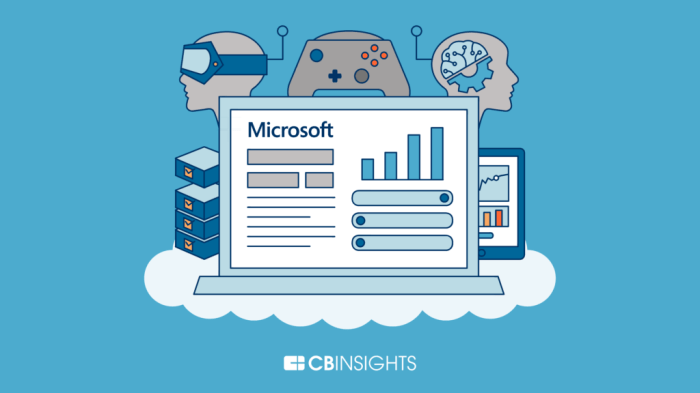
Should Microsoft give up and break up? This question sparks debate, examining the colossal tech giant’s market dominance and potential ramifications. From antitrust concerns and financial implications to technological advancements and social impacts, the analysis explores the intricate web of consequences surrounding a potential breakup. The potential for new entrants and innovation, and the broader economic and social implications, are also explored.
This in-depth exploration investigates Microsoft’s current market share and position in key sectors, comparing it to the competitive landscape and potential outcomes of a breakup. We delve into the historical context of antitrust regulations, scrutinize specific antitrust concerns, and analyze potential legal challenges. The financial implications, both for Microsoft and its stakeholders, are also thoroughly assessed.
Market Dominance and Competition
Microsoft’s substantial market presence across various sectors has fostered intense competition. Understanding its current position and the strategies of its rivals is crucial to evaluating the potential impacts of a breakup. This analysis examines Microsoft’s market share, key competitors, and the implications of a hypothetical division.Analyzing the competitive landscape requires a deep dive into Microsoft’s strengths and weaknesses in comparison to other industry giants.
A breakup, while potentially fostering innovation, could also lead to fragmentation and a weakened overall competitive posture.
Microsoft’s Current Market Share and Position
Microsoft holds a dominant position in several key sectors. Its products are deeply ingrained in consumer and enterprise ecosystems. The company’s diverse portfolio includes software, hardware, cloud services, and gaming. This extensive reach allows for cross-platform synergies and strong brand recognition.
Competitive Landscape Analysis
The tech industry is fiercely competitive. Major competitors like Google, Apple, and Amazon wield significant influence. Their strategies often involve innovation in cloud computing, mobile operating systems, and e-commerce, posing direct challenges to Microsoft’s dominance. These companies invest heavily in research and development, and continuously seek to enhance their product offerings and user experiences.
Comparison of Microsoft’s Position with Potential Breakup Outcomes
A hypothetical breakup of Microsoft could alter the competitive dynamics. A fragmentation of its business segments might create new, smaller entities. These entities would face increased pressure to compete with established industry players and their established product lines. This might necessitate significant investments in R&D and marketing, potentially diverting resources from existing core businesses. The impact on Microsoft’s overall market share and its ability to maintain its current position in the market would be a significant outcome to be studied.
Potential Effects on Competitive Dynamics
A breakup could create new opportunities for smaller companies. Existing competitors might gain more market share in specific segments, while the loss of Microsoft’s unified approach might lead to less innovation in areas of combined effort. The overall effect on the competitive dynamics would be a shift in power and potentially a period of transition.
The debate around whether Microsoft should break up rages on. While the tech giant grapples with antitrust concerns, news of CBS taking a majority stake in a web portal, like CBS takes first majority stake in web portal , highlights the ever-shifting landscape of media consolidation. This raises interesting questions about market dominance and potential future competition, ultimately impacting the discussion about whether Microsoft should be split up.
Table: Market Share and Key Products
| Company | Market Share (approximate) | Key Products |
|---|---|---|
| Microsoft | Significant market share in several sectors (e.g., Windows, Office, Azure, Xbox) | Windows OS, Microsoft Office Suite, Azure Cloud Services, Xbox Gaming Console, LinkedIn |
| Dominant in search, cloud, and mobile | Search Engine, Android OS, Google Cloud Platform, YouTube | |
| Apple | Strong in mobile devices and software | iOS, macOS, iPhone, iPad, Apple Watch |
| Amazon | Large market share in e-commerce, cloud, and AI | Amazon Web Services, Amazon Marketplace, Kindle, Alexa |
Antitrust Concerns and Regulations
Antitrust regulations are crucial for maintaining a competitive marketplace and preventing the formation of monopolies. These regulations, with roots in the late 19th century, were designed to foster fair competition and protect consumers from exploitation by powerful corporations. The core principle is that a competitive market benefits both businesses and consumers, ensuring innovation and lower prices.The historical context of these regulations is critical to understanding their application today.
Initially focused on preventing mergers that stifled competition, antitrust laws have evolved to address various anti-competitive practices. This includes controlling market share, preventing predatory pricing, and ensuring fair access to resources. This ongoing evolution reflects the changing nature of business and the need to adapt legal frameworks to modern economic realities.
Historical Context of Antitrust Regulations
The Sherman Antitrust Act of 1890, a cornerstone of US antitrust law, prohibits contracts, combinations, or conspiracies in restraint of trade. The Clayton Antitrust Act of 1914 further strengthened these regulations, prohibiting mergers and acquisitions that substantially lessen competition. These early laws were initially applied to industrial monopolies, such as Standard Oil and American Tobacco. Subsequent antitrust cases and regulations have broadened the scope to encompass a wider range of business practices and technologies, reflecting the dynamic nature of markets.
Specific Antitrust Concerns Related to Microsoft
Microsoft’s dominance in the operating system and related software markets raises significant antitrust concerns. Critics argue that Microsoft’s bundling practices, leveraging its market power to disadvantage competitors, and practices that limit choice for consumers constitute anti-competitive behavior. The integration of its products and services, and the potential for creating barriers to entry for new players, are also considered problematic.
These concerns often involve the potential for reduced innovation and higher prices for consumers.
Potential Legal Ramifications and Challenges Associated with a Breakup
A breakup of Microsoft would have significant legal ramifications, requiring careful consideration of the implications for consumers, competitors, and the company itself. Such a decision would likely be highly contested, with potential appeals and protracted legal battles. The courts would need to carefully weigh the arguments for and against a breakup, considering the potential benefits of increased competition against the potential costs of disrupting a large and established company.
Previous antitrust cases have established precedents that would guide the courts’ deliberations.
Different Regulatory Frameworks Across Various Jurisdictions
Antitrust regulations vary across jurisdictions, with differing legal standards and enforcement approaches. The EU, for example, has a distinct regulatory framework with its own emphasis on consumer protection and the need to maintain a competitive marketplace. The enforcement of antitrust laws can differ significantly between jurisdictions, leading to potential inconsistencies in the application of these rules. These differences in regulatory frameworks necessitate careful consideration of the implications for a company like Microsoft operating globally.
Key Antitrust Laws and Regulations
| Law/Regulation | Jurisdiction | Key Provisions |
|---|---|---|
| Sherman Antitrust Act | United States | Prohibits contracts, combinations, or conspiracies in restraint of trade. |
| Clayton Antitrust Act | United States | Prohibits mergers and acquisitions that substantially lessen competition. |
| European Union Antitrust Regulations | European Union | Focus on consumer protection and maintaining a competitive marketplace. |
| Other National Laws | Various Countries | Specific legislation across different countries, adapting to local market conditions. |
Financial Implications of a Breakup: Should Microsoft Give Up And Break Up
A potential breakup of Microsoft presents a complex web of financial implications, impacting shareholders, employees, industries, and consumers in both the short and long term. Understanding these ramifications is crucial for assessing the potential risks and rewards of such a significant restructuring. This analysis delves into the financial consequences for various stakeholders.
Potential Impact on Microsoft Shareholders
The short-term financial impact on Microsoft shareholders following a breakup would likely involve a period of uncertainty and potentially lower stock valuations. Shareholders may experience a decrease in market capitalization as the market adjusts to the loss of synergies and the perceived reduction in value of specific divisions. A breakup could result in the distribution of shares in separate companies, which could lead to uncertainty about the future performance of each entity.
The long-term impact depends significantly on the performance of the individual entities after the separation. Positive growth in the new entities could potentially offset any short-term losses.
Impact on Revenue and Profits
A breakup would likely lead to a temporary dip in revenue and profits as the newly formed companies adjust to their independent operations and potentially face increased competition. The loss of revenue synergies, which often occur when distinct business units collaborate effectively, could be substantial. The degree of impact will vary significantly based on the specific division and its competitive landscape post-separation.
For example, if a breakup separates Microsoft’s cloud services division from its gaming division, it would disrupt existing revenue streams and create uncertainty in market share for each new entity.
Impact on Affected Industries and Consumers
A breakup could have ripple effects across various industries. For instance, if Microsoft’s operating system division is separated from its hardware division, the hardware market might experience disruption, with potentially fewer innovative products and increased competition. Consumer choices might also be affected, depending on the competitiveness and product availability of the separate companies. Consumers might see some price increases or a decrease in product offerings due to the loss of synergies between different divisions.
Existing products and services might see a temporary decrease in quality or innovation if the synergy and collaboration between divisions are lost.
Financial Consequences for Employees
The breakup of Microsoft would undoubtedly impact its employees. Job losses are a potential consequence, especially in areas where roles are duplicated or interdependent between the different business units. The number of job losses would vary depending on the reorganization strategy of the newly formed companies. A strategic reorganization plan would minimize potential job losses.
Financial Scenarios Comparison Table
| Scenario | Revenue (Estimated Change) | Profit (Estimated Change) | Market Capitalization (Estimated Change) | Employee Impact |
|---|---|---|---|---|
| Breakup | Potential temporary decrease | Potential temporary decrease | Potential temporary decrease | Potential job losses |
| Status Quo | Potential continued growth | Potential continued growth | Potential continued growth | Potential job creation or maintenance |
Note: The estimates in the table are indicative and subject to significant variations depending on the specifics of the breakup plan and the subsequent performance of the new entities.
Technological Implications of a Breakup

A breakup of Microsoft, while potentially addressing antitrust concerns, could have profound and multifaceted effects on the technological landscape. The company’s current interconnected ecosystem, built on shared technologies and platforms, might be significantly altered. This change could stimulate or stifle innovation, depending on how the resulting entities adapt and interact. The impact on the pace of technological advancement in key sectors, such as software, operating systems, and cloud computing, is a critical consideration.
Potential Impacts on Innovation
The breakup could potentially spur innovation in various ways. Competition among newly independent entities might drive them to develop more specialized solutions and cater to niche markets, leading to diverse offerings and possibly more competitive pricing. For example, a competitor operating system might emerge, challenging the current market dominance, leading to a more dynamic and innovative market. Conversely, fragmentation could lead to diminished resources and slower progress in certain areas where shared resources were crucial for advancement.
The debate over whether Microsoft should break up rages on, but maybe a look at recent industry moves offers some perspective. The recent merger of CD Warehouse and CD Plus, as detailed in this article cd warehouse cd plus announce merger , suggests that consolidation can sometimes be a positive force, though it’s hard to draw direct parallels to the complexities of a tech giant like Microsoft.
Ultimately, the question of whether Microsoft should be broken up remains a complex one, with strong arguments on both sides.
Impact on the Pace of Development, Should microsoft give up and break up
The pace of development in software and operating systems could be affected in several ways. If resources are dispersed, development cycles might lengthen, and new features might take longer to emerge. Conversely, if the breakup fosters competition and specialized development, it could lead to accelerated innovation in specific areas, as companies focus on their core competencies. Examples of past industry breakups, like the early days of the PC revolution, show that competition can sometimes accelerate technological advancements.
Potential Collaborations and Partnerships
A breakup could create new opportunities for collaborations and partnerships. Smaller, independent entities might find it easier to forge alliances with complementary companies or start-ups to overcome specific challenges or leverage specialized expertise. The emergence of new, specialized technologies might require partnerships to create the required ecosystem. For instance, companies with specific strengths in artificial intelligence might partner with those strong in cybersecurity to advance these fields.
Benefits and Drawbacks to Technological Advancement
The benefits of a breakup in terms of technological advancement could be a more dynamic and competitive market. New, specialized technologies and innovative solutions might arise from the independent entities. However, drawbacks include potential fragmentation and slower advancement in certain areas. For instance, the breakup might hinder the development of integrated solutions that require collaboration across the different entities.
Comparison of Innovation Patterns Before and After
Before a breakup, Microsoft’s unified ecosystem might have fostered integrated solutions and certain technological advancements. After a breakup, a more fragmented landscape could lead to more specialized, potentially innovative solutions. The long-term effects on innovation patterns are complex and not easily predictable, depending on the specific strategies and collaborations undertaken by the new entities. Historical precedents of industry breakups, like the fragmentation of the telecommunications industry, provide some insight, though direct comparisons are challenging.
The debate around whether Microsoft should give up and break up is intense. But, considering a week of e-commerce snafus, like those highlighted in a week of e commerce snafus , perhaps a similar level of scrutiny is needed in evaluating the tech giant’s dominance. Ultimately, the question of a breakup remains complex and multifaceted.
Potential for New Entrants and Innovation
A breakup of Microsoft could potentially spark a surge in new competitors and innovative solutions across various tech segments. The current market dominance of Microsoft, particularly in operating systems and cloud computing, has historically limited the entry of new players. A fragmented landscape, however, could open the door for specialized firms to emerge and address niche markets, potentially driving innovation in areas currently underserved.The resulting competitive landscape could lead to more diverse offerings and push the boundaries of technological advancements, benefiting consumers in the long run.
This dynamic environment will require Microsoft and new entrants to constantly adapt and refine their strategies to maintain a competitive edge.
Opportunities for New Competitors
A breakup of Microsoft would create significant opportunities for new competitors to enter the market. This fragmentation would create openings in various market segments currently dominated by Microsoft. New companies could focus on specific applications, operating systems, or cloud services, catering to specialized needs or underserved niches. Existing competitors with a proven track record in specific areas could also expand their operations, capitalizing on the diminished market power of Microsoft.
Potential Benefits and Drawbacks to New Entrants
New entrants in a fragmented market face both opportunities and challenges. A significant advantage is the ability to tailor products and services to particular niches and specific customer requirements. However, competing against established giants like Microsoft would require significant financial investment and innovative solutions to gain market share. Furthermore, building a strong brand recognition and customer trust from scratch takes considerable time and effort.
The existing customer base of Microsoft would pose a challenge for new companies to acquire. A potential drawback is the steep learning curve in developing products and services that effectively compete with the vast portfolio of Microsoft.
Likelihood of Innovation with More Competitors
A fragmented market, characterized by multiple competitors, often fosters innovation. This is because companies vying for market share are incentivized to develop new and improved products and services. The competition pushes companies to develop creative solutions, leading to advancements in technology and potentially lower prices for consumers. This scenario is similar to the growth of the smartphone market, where a multitude of manufacturers spurred innovation in design, features, and operating systems.
Potential New Products or Services
A breakup of Microsoft could lead to a variety of new products and services. Specialized operating systems for specific industries or use cases could emerge. New cloud services focusing on niche markets or offering enhanced security and privacy features could also be developed. Alternative productivity suites targeting specific professional needs, perhaps with more streamlined or user-friendly interfaces, could emerge.
Table of Potential New Entrants and Their Strengths
| Potential New Entrant | Segment | Strengths |
|---|---|---|
| CloudOS Inc. | Cloud Computing | Focus on enterprise-grade security, customizability, and data sovereignty. |
| NovaSoft | Operating Systems | Specializing in low-resource computing devices, optimized for efficiency and longevity. |
| PixelFlow | Productivity Suites | Aimed at creatives, offering intuitive tools for photo and video editing, streamlined workflow, and seamless collaboration. |
| DataForge | Data Management | Innovative data analysis tools and solutions, focusing on user-friendliness and ease of integration with various platforms. |
Social and Economic Impacts

A breakup of Microsoft, while potentially fostering competition and innovation, would inevitably ripple through various communities and regions, impacting employment, access to services, and market stability. Understanding these social and economic consequences is crucial for a comprehensive evaluation of the proposed division. The potential positive and negative effects on different stakeholders will be detailed below.
Potential Impact on Employment Opportunities
The restructuring of Microsoft into multiple entities would necessitate significant organizational changes. Layoffs and job relocations are plausible consequences in some departments, while new opportunities might emerge in the newly formed companies. The scale and distribution of these effects would depend on the specific structure of the breakup and the strategies of the resulting entities. This could result in a complex shift in employment opportunities, with some individuals potentially losing jobs while others might gain them in different sectors.
Impact on Access to Services
Microsoft’s services, from cloud computing to software applications, are integral to many industries and individuals. A breakup could affect the availability and pricing of these services. Users might experience disruptions in service provision, or encounter price hikes. The transition period could be especially challenging for smaller businesses and developing economies, who may rely heavily on Microsoft’s services.
Market Stability and Consumer Impact
The breakup might lead to a more competitive market, potentially driving innovation and lower prices for consumers in the long run. However, the short-term effect could be market instability and price volatility as new players emerge and existing ones adjust to the altered landscape. Consumers might experience uncertainty about the availability and quality of products and services. The overall effect on the consumer experience would depend on the speed and effectiveness of the transition.
Potential Positive and Negative Effects for Different Stakeholder Groups
- Consumers: A breakup might lead to lower prices and increased choices in the long run, but could cause short-term disruptions and price volatility. The immediate impact will depend on the strategies of the new companies and the pace of the transition. Consumers who use Microsoft products and services would likely experience an adjustment period.
- Employees: Job losses are a potential concern in certain departments, but the emergence of new opportunities in the new entities could offset this. The outcome would depend on the handling of the transition by the new companies. The skills and experience of existing employees would play a crucial role in the future success of these companies.
- Investors: The breakup could impact investor confidence and potentially trigger a period of uncertainty. However, the long-term prospects for individual companies might be enhanced by increased competition and innovation. Investors need to analyze the potential risks and rewards based on the specific circumstances of each entity.
Socioeconomic Impact: A Summary Table
| Stakeholder Group | Potential Positive Impacts | Potential Negative Impacts |
|---|---|---|
| Consumers | Increased competition, lower prices, wider range of choices | Short-term disruptions, price volatility, potential quality issues |
| Employees | New job opportunities in newly formed companies | Job losses in certain departments, potential uncertainty |
| Investors | Potential for increased long-term profitability | Short-term uncertainty, potential for market volatility |
| Small Businesses | Access to potentially more affordable services | Potential disruption in services, difficulty in adapting to changes |
| Developing Economies | Access to potentially more affordable services | Potential disruption in services, difficulty in adapting to changes |
Conclusion
In conclusion, the debate surrounding a potential Microsoft breakup is multifaceted, touching upon market dominance, antitrust concerns, financial implications, technological innovation, and social impacts. A thorough analysis of these elements reveals a complex interplay of factors, demanding careful consideration of all perspectives before reaching a definitive conclusion. The potential for both positive and negative outcomes warrants a comprehensive understanding of the challenges and opportunities presented by such a dramatic restructuring.






